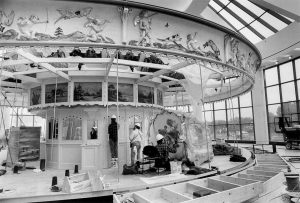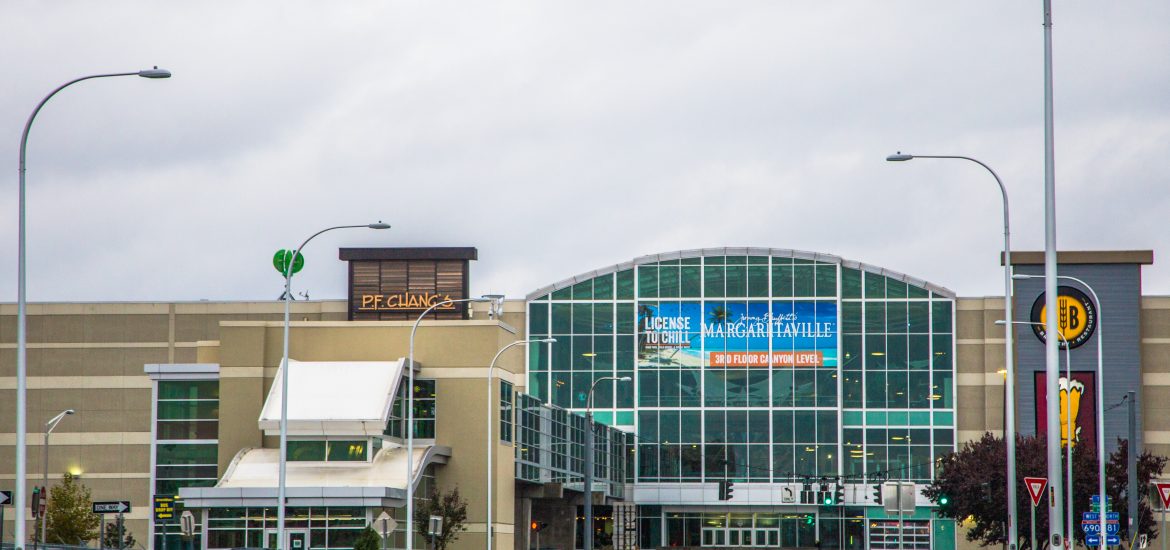A sea-green spire towers on the shores of long-polluted Lake Onondaga, surrounded by sprawling parking lots and a massive hotel. This is the crown of Destiny USA: Syracuse’s six-story, 2.45 million square-foot shopping center on the city’s Northside. It’s also an ever-present reminder of how a city on the decline tried to turn itself around with a massive investment into the retail industry, built quite literally on the remains of its once-great manufacturing district.
From the time it was built, Destiny USA was meant to be just what its name suggests — a shopping destination. There’s no other explanation for why the U.S.’s 183rd-largest city would need the country’s sixth largest mall, or why in September 2017, the same developers behind Destiny opened an Embassy Suites hotel with a beautiful view of the mall’s parking garage.
No, there was never any expectation for Central New York to support this retail wonderland on its own. That’s why Carousel Center — what Destiny was known as before 2012 — was built at the crossroads of I-81 and I-690, right on top of a toxic waste dump.

Developers built Destiny USA on Oil City, a wasteland overrun with abandoned buildings, oil tanks and industrial debris that poisoned nearby Lake Onondaga. A 1990 New York Times article described the area as “a kind of monument to 20th-century environmental arrogance, its future written off by government and business alike” — until the Pyramid Companies real estate agency came along.
Pyramid founder Robert Congel envisioned a waterfront business district, with the mall sparking retail, recreational and residential development that would stretch into downtown, according to a Syracuse.com article. Pyramid would start by cleaning up the 75-acre mall site, including 1.5 acres of contamination. The $2 million project ended up costing Pyramid $15 million before it could even start building.
The whole project was a risk for both Pyramid and the city of Syracuse. If it failed, Syracuse would lose out on $165 million in payments it was supposed to get from Pyramid in lieu of taxes. The city’s future would become even bleaker, showing that not even a multimillion dollar investment could clean up its toxic past. But it succeeded, and Destiny largely erased the memory of the hazardous waste beneath its floor.
Since its controversial conception, Destiny has brought some undeniable good to Syracuse. According to the mall’s website, Destiny employs about 5,000 people, not including construction and hotel employees. It brings in 29 million shoppers from the U.S. and Canada each year, according to the Pyramid website. And it seems to have stuck to its environmental roots, harvesting millions of gallons of rainwater and achieving LEED Gold Status.
But some say the city of Syracuse has overstated those positives, including former Mayor Stephanie Miner. She was quick to condemn tax breaks for Destiny’s hotel project.
“This type of trickle-down development, which OCIDA [the Onondaga County Industrial Development Agency] continues to support time and time again, does not benefit our citizens and instead takes money away from the poorest people in our community to further enrich wealthy developers,” Miner said in a 2016 statement.
With how Syracuse and Onondaga County’s tax system is set up, Destiny could easily bypass a deal from the city and turn to the OCIDA. So the mall still got a deal. And as Destiny has expanded from an everyday mall into a commercial paradise, it’s received more than $740 million in government subsidies. That’s more than Amazon and Google parent company Alphabet.
Destiny’s history is complicated, and its future even more so. Pyramid cleaned up toxic waste when it built Destiny, but didn’t do enough to stop it from bubbling back up when it built the Embassy Suites. It’s replaced the Oil City eyesore with economy-boosting commercialism, but only incorporated a few local businesses. It’s also created thousands of jobs, but utilized millions in subsidies funded by tax dollars.
So no, Destiny USA didn’t bring back Syracuse’s economy or manufacturing jobs. But it was the start of revitalization on Lake Onondaga’s shores, leading to construction of the nearby Onondaga Creekwalk and future development plans for the Inner Harbor. By cleaning up Oil City, Destiny become Syracuse’s saving grace.

